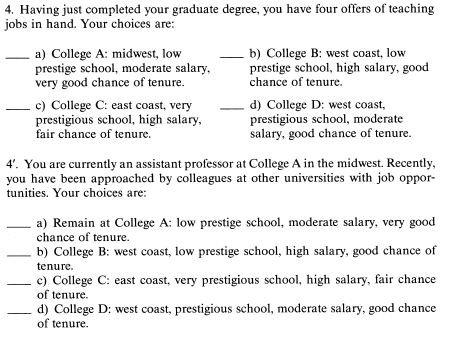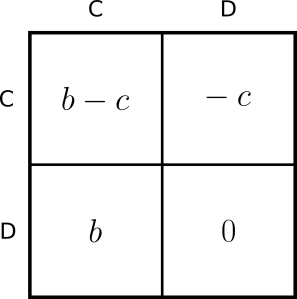This is round-up of the best books I read (or listened to) in 2013. They are ordered, roughly, from less-to-more academic.
Warning: In theory, if you click a link and buy a book, I get some sort of kickback. But please don’t buy a book just to see if I get a kickback.


Trial of the Clone: An Interactive Adventure! by Zach Wienersmith. In December 2012 my partner and I had placed two suspiciously similar packages for each other
by Zach Wienersmith. In December 2012 my partner and I had placed two suspiciously similar packages for each other under the tree next to the couch. We opened them simultaneously and discovered that both gifts were an interactive adventure by the husband of parasite ecologist Kelly Wienersmith. We spent an entire plane ride to Omaha, and much of the next day, working through our own adventures. I was an engineer. Emily was a fighter. Both of us died. Many. Times.
Back when I was about eight, my younger sister and I enrolled in a summer reading program at the library where we could earn a sticker for every five books we read. So we blew through 50-or-so Choose Your Own Adventure books in a week and earned sooo many stickers. So the library changed its policy to explicitly exclude CYOA books from the program. This is not that kind of book. Zach built in some role-playing-game style stochasticity and (unless you cheat) you are also likely to die. A lot. But it is worth it. Zach is the cartoonist behind SMBC comics, and if you enjoy its nerdy and irreverent sense of humor, you are likely to enjoy this book. (If not, you might still like it, but probably not). Also, if you use technology, there is an Android app of the book for your phone (voiced by Will “Wesley Crusher” Wheaton). And there appears to be a sequel in the works.


Nudge: Improving Decisions About Health, Wealth, and Happiness by Richard H. Thaler and Cass R. Sunstein. Thaler and Sunstein advance “libertarian paternalism.” The basic idea is that people should have many choices, but, using tricks of psychology, they can be “nudged” to make the “right” choices. The “right” choice is defined by what is good for the person or good for society. The hope is that what is good for the person or good for the societies is somewhat correlated with the person doing the nudging so these powers are not used for evil. In the first part of the book, the authors go through a series of cognitive biases that
by Richard H. Thaler and Cass R. Sunstein. Thaler and Sunstein advance “libertarian paternalism.” The basic idea is that people should have many choices, but, using tricks of psychology, they can be “nudged” to make the “right” choices. The “right” choice is defined by what is good for the person or good for society. The hope is that what is good for the person or good for the societies is somewhat correlated with the person doing the nudging so these powers are not used for evil. In the first part of the book, the authors go through a series of cognitive biases that people Western college students seem to have. One, the status quo bias, is where, when people are given a choice, they tend to go with the status quo option. For example, in countries where people have to check a box to be an organ donor, organ donation rates are much lower than in countries where people have to check a box to opt-out of being an organ donor. If a policy-maker thinks that organ donation is the “right” choice then they might want to make it an opt-out option. There are many examples like this.
The second part of the book delved into specific policy perscriptions, but the authors sort-of lost me here. In one example, they advocate for privatizing marraige (i.e., getting the government out of it completely). While this may be a good policy idea (it certainly is libertarian). It seemed only loosely related to the cognitive biases described in the first half of the book. There are many examples like this. I highly recommend the first part of the book, but if you decided to skip the second part, I wouldn’t blame you.


Thinking, Fast and Slow by Daniel Kahneman. This book hit the mark. I would recommend it to anyone interested in decision science. It is similar to Nudge in some of the ground it covers (the authors feature prominently in each other’s books), but spends more time on the science and less on the policy prescriptions. The book mainly discusses the series of experiments Kahneman and his late collaborator, Amos Tversky, conducted into the biases humans use in assessing risk and decision-making – experiments for which Kahneman won the economics version of the Noble prize. Here are a couple examples from their research.
by Daniel Kahneman. This book hit the mark. I would recommend it to anyone interested in decision science. It is similar to Nudge in some of the ground it covers (the authors feature prominently in each other’s books), but spends more time on the science and less on the policy prescriptions. The book mainly discusses the series of experiments Kahneman and his late collaborator, Amos Tversky, conducted into the biases humans use in assessing risk and decision-making – experiments for which Kahneman won the economics version of the Noble prize. Here are a couple examples from their research.
Here is another. Take these two questions:
Would you accept a bet that offers a 90% chance to lose $5 and a 10% chance to win $95?
Would you pay $5 to participate in a lottery that offers a 10% chance to win $100?
It turns out that many more people will take the second offer and than the first – even though the outcomes are the same for both. This is a problem for utility theory – a theory of decision-making often used by economists. Utility theory assumes agents have preferences over outcomes, independent of their previous state. Kahneman and Tversky’s “prospect theory” describes how actual humans make decisions in reference to earlier states. That is, we make decisions, in part, on how much we stand to gain or lose relative to where we are now – our current state matters. This is one of those findings that sounds like “common sense” to most people, but has made people rethink the common simplifying assumptions of an entire discipline.
I heard a lot about these last two books at the Summer Institute on Bounded Rationality a few years ago. The main gripe against Nudge from some of the participants is that paternal libertarianism seemed too, well, “paternal.” The main gripe with Thinking, Fast and Slow, was that Kahneman seemed too focused on the negative aspects of decision-making biases and heuristics and not enough on the positive aspects. The argument was that most of the time these biases serve us well, which is why we use them. Kahneman, the argument goes, focuses too much on where they lead us astray missing the forest for the trees. If you are interested in this different perspective Gerd Gigerenzer’s Simple Heuristics that Make Us Smart is a pretty good start.


The Sports Gene: Inside the Science of Extraordinary Athletic Performance by David Epstein. I expected to really dislike this book. I expected to be grumpy about 90% of the time when
by David Epstein. I expected to really dislike this book. I expected to be grumpy about 90% of the time when reading it listening to it in my car. However, despite its terrible title, I thought it was a fairly balanced look about the possible contributions of genes, training, and culture to sports performance. I was only grumpy about roughly 15% of the time. Overall, I think the book could better highlight the distinction between explaining variation in athletic performance at the individual level (e.g., two athletes undergoing the same training with different results) and variation in performance between groups (why Jamaica seems to have so many good sprinters relative to its population). And the author is much quicker than I’d like to suggest that unexplained variation at both scales is due to genetic variation. But he does point out, for example, that sprinters have a lot of prestige in Jamaica and that someone as large and fast as Usain Bolt in the United States would likely have gone into American football and be earning a lot more money (or be sidelined with injuries). So overall a mixed bag, but much better than I expected.


Why Nations Fail: The Origins of Power, Prosperity, and Poverty by Daron Acemoglu and James Robinson. The authors of this book present a series of case studies, arguing that differences in whether nations succeed or fail is due to differences in political and economics institutions. The basic premise and arguments seem very plausible and I think they do a convincing job pointing out flaws in competing hypotheses, such as Jared Diamond’s geography-centric ideas. However, I am really interested in why there are such differences in political and economic institutions in the first place. Is it just historical accident? Is there something more to it? This book does not get into these questions as much as I’d like, but it was still engaging.


Brainwashed: The Seductive Appeal of Mindless Neuroscience by Sally Satel and Scott O. Lilienfeld. This was an engaging and rather short read about reasons you might be skeptical about the types of claims that are sometimes made in neuroscience. The two main problems are these:
by Sally Satel and Scott O. Lilienfeld. This was an engaging and rather short read about reasons you might be skeptical about the types of claims that are sometimes made in neuroscience. The two main problems are these:
1) There is an over-reliance on null-hypothesis testing and multiple comparisons. There are a very large number of possible areas of the brain that are tested and some non-trivial number of these will come back positive by chance using p < 0.05 without any controls for multiple tests. This leads to a very high false positive rate. This is the point of the (in)famous (Ig) Nobel-prize winning dead salmon study.
2) When you read something like “the scientists found that X part of the brain lit up, which makes sense because X part of the brain is associated with function Y,” you should be skeptical. The reason is because every X part of the brain is associated with a very large number of function Y’s. And most Y’s are associated with multiple X’s. So it is often pretty easy to find an association between X and Y that “makes sense” after the fact.


Paleofantasy: What Evolution Really Tells Us about Sex, Diet, and How We Live by Marlene Zuk. The basic story here is that the ways humans lived in the paleolithic was much more varied than most people, including a surprising number of scientists, assume. It is problematic to make arguments about modern humans from the ways that our “hunter-gatherer” ancestors lived, because hunter-gatherers likely had many different ways of living. Some of her main targets are evolutionary psychologists, who have a reputation for hypothesizing about how human’s psychology “would have evolved” in hunter-gatherers, without being too concerned about the evidence for how hunter-gatherers actually lived. Another of the book’s targets, and the one that seems to have gotten the most attention, is the Paleo diet and its derivatives. I do not have much of a dog in this fight, but her arguments seemed reasonable. However, she spent more time than I’d have liked responding to pro-Paleo diet blog comments relative to claims made by the original Paleo-diet books. Sometimes I wondered how much of this was fighting straw men.
by Marlene Zuk. The basic story here is that the ways humans lived in the paleolithic was much more varied than most people, including a surprising number of scientists, assume. It is problematic to make arguments about modern humans from the ways that our “hunter-gatherer” ancestors lived, because hunter-gatherers likely had many different ways of living. Some of her main targets are evolutionary psychologists, who have a reputation for hypothesizing about how human’s psychology “would have evolved” in hunter-gatherers, without being too concerned about the evidence for how hunter-gatherers actually lived. Another of the book’s targets, and the one that seems to have gotten the most attention, is the Paleo diet and its derivatives. I do not have much of a dog in this fight, but her arguments seemed reasonable. However, she spent more time than I’d have liked responding to pro-Paleo diet blog comments relative to claims made by the original Paleo-diet books. Sometimes I wondered how much of this was fighting straw men.


Institutions, Institutional Change and Economic Performance by Douglass North. This is one of those books that I wish I would have read back when I got into institutions. It is a classic and everyone references it. As I was reading, I kept giving North little air high fives. I really liked this book! I realize that most people are not going to have the same reaction to this book that I did (which is why it is so far down on the list) but if you are interested in institutions or institutional change, this is part of the foundation.
by Douglass North. This is one of those books that I wish I would have read back when I got into institutions. It is a classic and everyone references it. As I was reading, I kept giving North little air high fives. I really liked this book! I realize that most people are not going to have the same reaction to this book that I did (which is why it is so far down on the list) but if you are interested in institutions or institutional change, this is part of the foundation.


Managerial Dilemmas: The Political Economy of Hierarchy by Gary J. Miller. My main research program is currently the origins of hierarchy and this is a great overview of issues surrounding the theme hierarchy in both an institutional economics and organizational behavior framework. It connects social choice theory with principle-agent problems and public goods problems in a nice tidy package. I recommend it to anyone interested in hierarchy in moderately complex organizations. Again, I realize this stuff is not everyone’s cup of tea, but it really helped get my thoughts about these topics organized.
by Gary J. Miller. My main research program is currently the origins of hierarchy and this is a great overview of issues surrounding the theme hierarchy in both an institutional economics and organizational behavior framework. It connects social choice theory with principle-agent problems and public goods problems in a nice tidy package. I recommend it to anyone interested in hierarchy in moderately complex organizations. Again, I realize this stuff is not everyone’s cup of tea, but it really helped get my thoughts about these topics organized.
I guess my only issues with these last two books is that I would have liked more in the way of toy mathematical models. But, again, I recognize I am often in a small minority in this regard.












